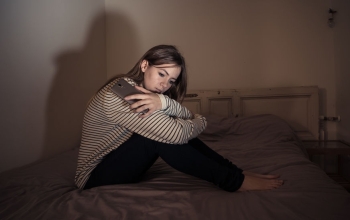
PTSD Treatment in Philadelphia: 267-324-9564
Some of the actual symptoms of PTSD can cause a person to isolate himself/herself. PTSD is characterized by three categories of symptoms: hyperarousal, intrusion and constriction. The way people cope with these symptoms can also contribute to isolation. Furthermore the way family, friends, co-workers and strangers interpret these behaviors and respond to them can contribute to isolation. To better understand the cycle of isolation review the PTSD symptoms and how they impact a person’s desire and ability to be social, review the categories of symptoms below.
-Hyperarousal Symptoms: Hyperarousal includes the feeling of being on guard and feeling very vigilant about your safety. Startling easily, difficulty concentrating, irritability, experiencing outbursts of anger and trouble sleeping are a part of hyperarousal. All of these symptoms can contribute to a limited ability to socialize.
- What this may look like: A person with PTSD might turn down offers to go out because they are too exhausted, as living with hyperarousal is physically and emotionally exhausting. Hyperarousal can also effect a person’s ability to snap out of a mood and a person with PTSD might find their tolerance for annoying people to be much less than what it once was. To preserve their physical and emotional energy a person with PTSD may choose to limit their social interactions because they find interacting with other people so exhausting and frustrating.
- What the trauma survivor needs from others: The trauma survivor needs others to understand that their patience and energy levels are not what they used to be. To demonstrate this understanding, check-in about their energy level in the actual moment of an experience and see where they are. Also check in at the start of the day and be flexible with social plans. For instance, maybe your friend with PTSD may no longer feel like they could get through a dinner with 10 other friends, but would like to go to a movie with you where they can relax and not have to engage with people as much. If you’re unable to be flexible with changing your plans, do not hold this against your partner, friend or family member with PTSD.
-Intrusion: Intrusion includes flashbacks, which is the experience of re-living the traumatic event. People with PTSD might also be bothered by the images or memories of the trauma as they are trying to go about their daily activities. They often experience nightmares, which are repetitive and frightening. The nightmares might include aspects of the traumatic event, or may be symbolic of the traumatic event. Other individuals will experience bizarre or graphic nightmares that do not directly remind them of the traumatic event.
- What this may look like: Intrusive memories and flashbacks can interfere with a person’s ability to be in the moment and interact with the people they care about, as well as complete daily tasks. You may find yourself whether your friend, partner or family member with PTSD is not paying attention to you. The nightmares the person with PTSD experiences may also rob them of sleep, and thus energy, so this will interfere with their ability to interact socially or complete daily tasks.
- What the trauma survivor needs from others: Check in with your friend, partner or family member that has PTSD if you feel like they are distracted or spaced out when you are trying to interact with them. This will help bring them back to the moment, and clarify what this behavior is about. Also find out what kind of support they might find useful and then try to implement that specific type of support.
-Constriction: Constriction includes when a person “numbs” to avoid feelings. In the moment of the trauma, numbness may have been needed to survive the events. Unfortunately if numbness is used as a long-term coping strategy, a person will feel and appear emotionless. A person who is “numbing” may feel detached or uninterested in their life. Activities someone used to enjoy may no longer be of interest, and generally a person can feel very apathetic about or indifferent about their life. Part of constriction also includes feeling as if there is not a future. In addition, constriction also includes avoiding people, places and things that remind the person about the trauma.
- What this may look like: Emotional numbing could be misinterpreted as the person with PTSD again not caring or not being interested in the other person. Feeling like there is no future can worry family and friends, and again might come off as the person with PTSD not caring about the relationship. For instance, the husband of a trauma survivor might fear his wife no longer wants to be with him because she will not engage in talk about the future. Avoiding people, places and things that remind the trauma survivor of the trauma will protect them from feeling triggered. However, this obviously limits who a person will spend time with, how they will spend time with them and where they will spend time with them.
- What they need from others: The trauma survivor needs others to ask what their behavior is about. Do not make assumptions. Give the trauma survivor the chance to understand and explain their own behavior. Understand that the difficulty to think or plan about the future is likely temporary, and not necessarily something personal towards you. If the person with PTSD is not self reflective enough to know what their behavior means, throw out some ideas or encourage them to seek counseling.
Remember…the cycle of isolation is kept in place by the PTSD symptoms themselves, the person’s coping mechanism’s to these symptoms, and other’s responses to the trauma survivor. The person with PTSD is not the only person impacted by the PTSD symptoms. Family, friends, co-workers, even strangers will respond to the behavior that the trauma survivor is engaging in. Without understanding and explanation, there is a lot of room for misinterpretation on both sides. Sadly, the negative experiences that the trauma survivor have in interacting with others, and the experiences that others have interacting with the trauma survivor, can reinforce the desire or need for isolation.





















